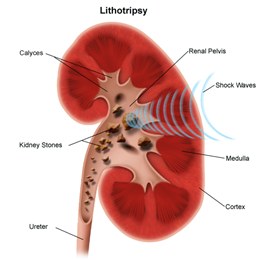Laparoscopic Cyst Ablation

Laparoscopic kidney cyst ablation is a minimally invasive surgical technique to remove symptomatic kidney cysts while preserving the remainder of the kidney. It is intended to help patients who experience flank pain, abdominal pain or have a obstructed kidney due to kidney cysts.
When compared to the conventional open surgical technique, laparoscopic cyst ablation has resulted in significantly less postoperative pain, a shorter hospital stay, earlier return to work and daily activities, a more favorable cosmetic result and outcomes that appear to be identical to that of open surgery. Laparoscopic kidney cyst ablation has become a standard procedure for select patients with symptomatic renal cysts.
The Surgery
Laparoscopic kidney cyst ablation is performed under a general anesthetic. The typical length of the operation is three to four hours. The surgery is performed through three or four small (1 cm) incisions made in the abdomen. A telescope and small instruments are inserted into the abdomen through these keyhole incisions, which allow the surgeon to completely dissect, free and excise the relevant kidney cyst(s) without having to place his or her hands into the abdomen.
Potential Risks and Complications

Although this procedure has proven to be very safe, as in any surgical procedure there are risks and potential complications. The safety and complication rates are similar when compared to the open surgery. Potential risks include:
-
Bleeding: Blood loss during this procedure is typically minor and a transfusion is needed in less than five percent of patients. If you are interested in autologous blood transfusion (donating your own blood) before your surgery, you must make your surgeon aware. When the packet of information is mailed or given to you regarding your surgery, you will receive an authorization form for you to take to the Red Cross in your area.
-
Infection: All patients are treated with intravenous antibiotics, prior to starting surgery to decrease the chance of infection from occurring after surgery. If you develop any signs or symptoms of infection after the surgery (fever, drainage from your incisions, urinary frequency or discomfort, pain or anything that you may be concerned about) please contact us at once.
-
Tissue / Organ Injury: Although uncommon, possible injury to surrounding tissue and organs including bowel, vascular structures, spleen, liver, pancreas and gallbladder could require further surgery. Scar tissue may also form in the kidney requiring further surgery. Injury could occur to nerves or muscles related to positioning on the operating table
-
Hernia: Hernias at incision sites rarely occur since all keyhole incisions are closed carefully at the completion of your surgery
-
Conversion to Open Surgery: The surgical procedure may require conversion to the standard open operation if difficulty is encountered during the laparoscopic procedure. This could result in a larger than standard open incision and possibly a longer recuperation period.
-
Urine Leak: If the urinary collecting system of the kidney is injured or needs to be cut across in order to remove the kidney cyst, it is usually sutured closed. If urine leaks out of this hole, you may need to have an internal drainage tube (ureteral stent) to help seal the leakage. On rare occasion you may require additional surgery.
It is very important that you gather and bring all of your X-ray films and reports to your initial consultation with your surgeon.



